Introduction
There have been many theories and speculations on the possibilities of who and where Sauron’s greatest servants came from.
To better understand their origins, we must carefully analyse a specific period in time, and cross-reference it with different sources – trying to build a framework of all the events that occurred at that point in time.
That is the purpose of this essay. To shed light on the information that is available to us and construct a theory on several possibilities through calculated conclusions.
Needless to say, though everything presented her comes from Tolkien’s own sources, the end result is entirely based on speculation from the texts and my own interpretations; and are not intended to be perceived as fact.
What we know
It is a known fact among Tolkien readers that the only indications we have to any of the Nazgûl’s past histories, concern mainly three things:
1) Three of the Ringwraiths were originally men of Númenor
2) The leader of the Nine was known as the Witch-King
3) The second in command was Khamûl, an Easterling
The rest of our knowledge on Ringwraiths is based on their characteristics and behaviours channeled through their actions in The Lord of the Rings and a couple of descriptions in The Silmarillion and Unfinished Tales.
Thus, from here onward we must speculate and reason out what is made available to us – hoping to shed some light on the matter.
In order to begin our quest in exploring deeper the history of the Ringwraiths, we must first go through the different sources we have at our disposal – mainly, timelines and specific quotes that point towards the unknown aspects of these beings.
Handing out the Nine Rings of Power, was not merely a case of distributing them freely and at will, but rather a specific, political and strategic move in order for Sauron to assure himself of future victories and control over Middle-earth.
Establishing a timeline
The first thing we need to consider are two important dates: the creation of the One Ring and the first appearance of the Nazgûl. In The Lord of the Rings (‘The Tale of Years’) we are informed that Sauron forged the Ring in the Second Age, c.1600.
Taking a few dates from the Appendix, we find the following dates:
The date around 1800 is important because it indicates an approximate time when Sauron may have begun to give the Rings of Power to Men. In The Silmarillion we are given a clear-cut description of how the Ringwraiths came to be:
“Those who use the Nine Rings became mighty in their day, kings, sorcerers, and warriors of old. They obtained glory and great wealth […] They had, as it seemed, unending life …”
– ‘Of the Rings of Power’
In order for Men to be perceived as having a longer lifespan than usual, several hundred years would need to have passed since receiving such rings, in order to justify this unnatural occurrence.
Thus, with the Nazgúl emerging in the year 2251, would indicate that the Nine received their respective Rings sometime between 1600 (the creation of the One Ring) and 1800 – allowing over 500 years for them to acquire extraordinary power and slowly turn into wraiths.
The Darkening of Númenor and the Conquering of Eriador
Having established a fairly accurate timeline to explore the beginnings of the Ringwraiths, we must look to events which occurred both in Middle-earth and in Númenor.
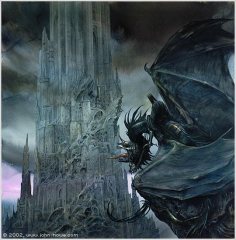 We have already read how, after the creation of the One Ring, Sauron invades Eriador and destroys Eregion (1695-1697). It would take three more years until 1700, when Tar-Minastir (the current King of Númenor) sends an army and defeats Sauron.
We have already read how, after the creation of the One Ring, Sauron invades Eriador and destroys Eregion (1695-1697). It would take three more years until 1700, when Tar-Minastir (the current King of Númenor) sends an army and defeats Sauron.
Before that event, the Dark Lord would have had precious little time (maximum five years) to subdue some of the Men by gifting them with several rings. Unfortunately, we have no evidence of any “kings” that surfaced from that area, but it is a definite possibility that one or two “sorcerers, and warriors” remained hidden in the shadows within the confines of Eriador; until they became completely enslaved by Sauron (see more in ‘The Remaining Two Ringwraiths’ below).
During these events, we also have the slow uprising in Númenor against the Ban of the Valar and the Valar themselves. What is so significant about this period in Arda’s history is the sudden migration towards the western shores of Middle-earth by many Númenóreans, intent on subduing the lesser Men living in and around the coastal regions.
“The King’s Men sailed far way to the South, and the lordships and strongholds that they made have left many rumours in the legends of Men.”
The Silmarillion, ‘The Akallabêth’
Thus, they came to Middle-earth “as lords and masters and gatherers of tribute”. It is almost a certainty that several of the Nazgûl came from this period, as we are further told by  Tolkien: “… it is said that among those whom he [Sauron] enslaved with the Nine Rings three were great lords of Númenórean race.”
Tolkien: “… it is said that among those whom he [Sauron] enslaved with the Nine Rings three were great lords of Númenórean race.”
The Witch-king, leader of the Nine, would most probably have been one of these Black Númenóreans, who came to conquer and settle on Middle-earth’s shores.
It’s fascinating to consider this small point in relation to three of the Ringwraiths being Númenóreans. In Unfinished Tales, Christopher Tolkien writes: “At the Ford of Bruinen only the Witch-King and two others, with the lure of the Ring straight before them, had dared the river” (‘The Hunt for the Ring’, Note 3).
Could this be precisely due to the fact that these same three servants had been “men of the sea” once?
A definitely possibility.
Rhûn and Khand
In order to continue analysing the remaining Ringwraiths, it would be wise to tackle the only other Nazgûl whose name has been given to us: Khamûl.
“Second to the Chief, dwelt in Dol Guldur after its reoccupation in the Third Age. Called the Shadow of the East, the Black Easterling.”
– Unfinished Tales, ‘Index’
At first glance, it would be tempting to state that Khamûl might have originated from Khand, due to the similar initial lettering of “kha”. However, the above quote states he was a  “Black Easterling”, a race of people which came out of the lands of Rhûn.
“Black Easterling”, a race of people which came out of the lands of Rhûn.
It would be safe, therefore, to assume that this particular Ringwraith was originally a man of Rhûn and just like the Black Nûmenóreans, became influenced by the Dark Lord and acquired one of the Rings of Power.
Having disregarded Khand as a possible candidate for Khamul’s origins, we still cannot overlook its relevance. Residing close to the land of Mordor, and having been its ally through the Ages, it is highly plausible a Ringwraith could have come from that land just south-east of Sauron’s realm.
That brings the count to a total of five. Three Ringwraiths from Númenor, establishing themselves on the West coasts and two more from the East.
Strategic motives behind Sauron’s choice
If we were to take the above speculations into account, it is interesting to see how Sauron employed a strategic tactic in order to ensure total dominion over Middle-earth.
By the year SA 2251, with the aid of his Ringwraiths, Sauron would have had complete control over the Eastern lands of Middle-earth through Rhûn and Khand (and Mordor itself), whilst three others of his servants, could have been dwelling along the south western coasts.
Sauron would have needed, not only the Ringwraiths themselves, but also entire groups of people strongly under his dominion. Thus, between the years 1600 and 2251, those Men who had in possession the Nine Rings, would have established kingdoms of their own and controlled a large following.
This can be confirmed over a thousand years later, prior to the War of the Last Alliance when “Sauron gathered to him great strength of his servants out of the east and south […] and among them were not a few of the high race of Númenor.”
–The Silmarillion, ‘Of the Rings of Power’
The Matter of Herumor and Fuinur
During the later part of the Second Age, we discover the existence of two individuals from the race of Men, “Herumor and Fuinur, who rose to power among the Haradrim” (The Silmarillion, ‘The Akallabêth’).
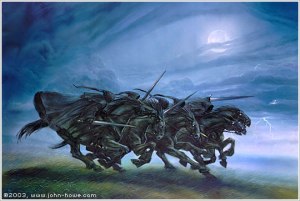 Both of them came from Númenor and fell under the power of Sauron when he was captured by Ar-Pharazôn. They later sailed East and established lordships in Harad and many readers believe that these eventually became two of the Ringwraiths.
Both of them came from Númenor and fell under the power of Sauron when he was captured by Ar-Pharazôn. They later sailed East and established lordships in Harad and many readers believe that these eventually became two of the Ringwraiths.
However fascinating this idea is, it must be emphasized that both of these Men became Black Númenóreans well after the emergence of the Ringwraiths and therefore, could not have been these same servants themselves.
However, it is interesting to consider why they chose the land of Harad. One can justly speculate that two Men (who would later on become Nazgûl) came from this region, over 1,700 years before and established a following of sorts – to which both Herumor and Fuinur would have settled in and continued the cult in favour of Sauron.
“The King’s Folk establish lordships in Umbar and Harad and in many other places on the coasts of the Great Lands.” (The People’s of Middle-earth, ‘The Tale of Years of the Second Age’, Section T4).
The following event takes place between 2000-3000 of the Second Age (according to Tolkien’s drafts), a time when the Black Númenóreans began to rise against the people of Middle-earth.
The word “lordships” seems a strong indicator as to the origin of one or two Ringwraiths.
This would provide a very strong reason for the Haradrim (or part of them) to have become allies with Sauron during the War of the Ring.
The Remaining Two Ringwraiths
The final two sources from which the Nazgûl could have originated, are the regions of Eriador and the White Mountains. Both the original Easterlings (from the First Age who dwelt west of Middle-earth and came over into Beleriand) and the Men of the Mountains, seem to be eligible candidates.
” Of the people of Bór, it is said, came the most ancient of the Men that dwelt in the north of Eriador afterwards in the Second Age.”
– Morgoth’s Ring, ‘The Grey Annals’, Note 466).
Knowing already that Eriador is soon to be conquered by Sauron, it would not be a far-fetched thought to ponder on the possibility that one of these “ancient Men” fell under the power of the Dark Lord and acquired one of the rings.
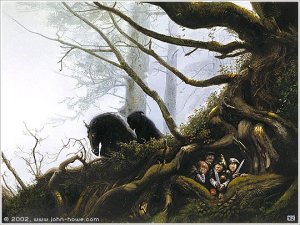 The other possibility situates itself among the Men of the Mountains, from whom came the Dunlendings (who during the Third Age posed a serious threat to the Rohirrim) and the Dead Men of Dunharrow.
The other possibility situates itself among the Men of the Mountains, from whom came the Dunlendings (who during the Third Age posed a serious threat to the Rohirrim) and the Dead Men of Dunharrow.
Originally, they dwelt in Minhiriath (south of Eriador), but after the Númenórean incursions during the Second Age, they scattered – some making their way towards Dunland to the east and the White Mountains further South.
“The native people were fairly numerous and warlike […] scattered communities without central leadership” but as the felling of trees by Aldarion (sixth king of Númenor) increased, “they attacked and ambushed the Númenóreans when they could […] and the native folk that survived fled from Minhiriath […] From Enedwaith they took refuge in the eastern mountains where afterwards was Dunland” (Unfinished Tales, ‘The History of Galadriel and Celeborn’).
The most intriguing part of this text however, comes in the following lines: “The denuding of the lands was increased during the war 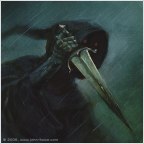 in Eriador; for the exiled natives welcomed Sauron and hoped for his victory over the Men of the Sea.”
in Eriador; for the exiled natives welcomed Sauron and hoped for his victory over the Men of the Sea.”
Thus, even before being conquered by Sauron, many of the men living in those surrounding lands, had begun to fall under his influence – strongly linking the emergence of the Ringwraiths with the above speculations on Eriador.
As to the matter of the Dead Men in the White Mountains, could it be that later on in the Second Age, they intentionally refused Isildur’s call to fight during the War of the Last Alliance? Is it possible that they had been lured by the power of a Ringwraith that rose among them when they had first settled there?
Conclusion
Throughout this article I have tried to stress the strategic importance in choosing specific regions of Middle-earth that would aid Sauron’s goal for domination.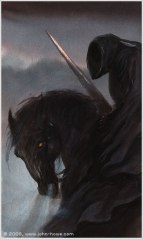
Keeping in mind the above speculations, three established Ringwraiths from the West, four from the East and two more from the Eriador and Enedwaith regions, would have provided the perfect opportunity to attack the Free People’s from all directions.
This is not to say that what happened in later years (in favour of the Dark Lord), was done in hindsight; but rather, what he did during the early part of the Second Age, indirectly affected the progress of the war against the races of Middle-earth.
Ultimately, even though I have tried to establish a concrete origins history for the Nazgûl, their power and allure lies in their mysterious being.
Exploring these unknown creatures in The Lord of the Rings, is what provides for a powerful reading experience that seems to strongly withstand the test of time.
All copyright to the illustrations shown here belong to John Howe
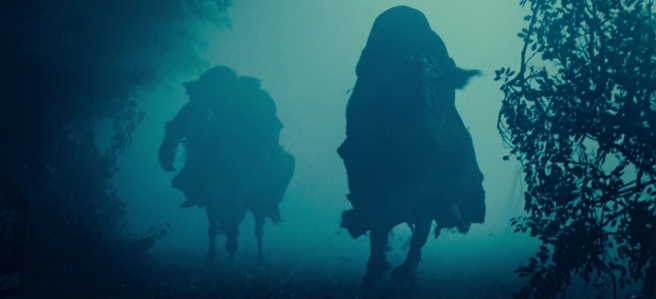




Reblogged this on Le Vanity Victorienne.
A fascinating essay. Just recently discovered your blog and I expect to lose several hours exploring it.
Hey Paul, thanks a lot! Hope you find other interesting posts 🙂
Excellent article! I really enjoyed reading it and getting some insight in a topic I am not be familiar with the movies aside.
Thanks! It’s all speculation of course, but it’s nice to propose ideas out there to the Tolkien fandom 🙂
An interesting study. Thank you for tackling this.
You’re welcome 🙂
Cool, cool! Little is known of the Ringwraiths, even less is known of their origins. But this surely goes some way to bringing their stories to the fore. Cheers!
Thank you for reading (and following) 😉
Very interesting post!
And a marvelous choice for the illustrations – John Howe is the best one on Nazgul (with these that you published and many others about the same theme)
Thanks! You are right, John Howe’s illustrations are exceptional …
A damn amazing post, great theories!
Cheers 😉
Fascinating theories! (not to mention an awesome blog in general. I’m liking and finding you more akin to myself with every article I read; please keep them coming!)
However I was surprised that you didn’t even entertain the possibility of the Witch King’s pre-wraith identity as none other than Ar-Pharazon the Golden, the last and most powerful King of Numenor himself! In my opinion he is the likeliest candidate for the Witch King (colloquially “Wiki”) if you consider all of their similarities. Since the Witch King was “probably of Numenorean descent” according to Tolkien, wouldn’t it make sense for the most powerful Nazgul to have originally been the most powerful Numenorean king?
The Ringwraiths were first sighted in SA 2251, but that does not necessarily mean that there were nine of them at this point. The first actual sighting of the Witch King specifically is when he fought in the war against the Last Alliance in 3434. Therefore it is plausible for Ar-Pharazon to have been given a Ring of power by Sauron sometime after the Numenoreans invaded Mordor and captured Sauron in 3261. Indeed, this prospect even supports Sauron’s seduction and eventual control over the King of Numenor as recorded in the Akallabeth. The allure of a Ring of power and the promise of glory, wealth, and long life would surely be very enticing to the King and may have been what finally corrupted him.
Deceived by Sauron, Ar-Pharazon eventually openly practised sorcery and the worship of the Dark and the Lord thereof, which would explain the Witch King’s use of sorcery.
The only thing that I can think of that could possibly make this theory implausible would be the fact that
“…Ar-Pharazon the King and the mortal warriors that had set foot upon the land of Aman were buried under falling hills: there it is said that they lie imprisoned in the Caves of the Forgotten, until the Last Battle and the Day of Doom.” (Akallabeth, p. 334)
But note that it is SAID that they will lie there until the Dagor Dagorath, ie. that it is only rumoured and not his definite doom.
My theory is that – if all of the above musings be true – since Ar-Pharazon has at this point one of the nine Rings of power and thus faux immortality, Sauron could have (being not a but THE Necromancer) resurrected the King and summoned him back to Mordor, swimming or no.
Now, some might say that this apparent “overruling” of Eru’s will even by Sauron would be preposterous, but I say that it would make perfect sense for Eru to allow this. After all, since immortality was what Ar-Pharazon was after, couldn’t this be Eru’s way of saying “So be it. I’ll give you over to your desires. Have it your way.”
This is in my eyes the best answer to the mystery of the Witch King’s former identity. While not fact, it is the most convincing possibility of the origins of the Witch King that I know of.
Above all, I’ve found that this link between the two (or perhaps one?) gives the Witch King so much more depth and authenticity, making him one of the most interesting characters in all Tolkien’s works, and in any case one of my all-time favourites.
Hey John, huge thanks for your comments!
As to the speculation on the Witch-king, it is a very tantalising idea to link him to Ar-Pharazon. You are correct in stating that the SA2251 date might not necessarily refer to all Ringwraiths.
However, we know from the Akallabeth that Ar-Pharazon, along with all this army sailed to Valinor and were there trapped in the Caves of the Forgotten until the Dagor Dagorath (Final Battle) – so it would be highly unlikely for him to have become a Ringwraith.
Fascinating discussion though and please keep on commenting 🙂
Of course we can all agree he was trapped beneath the fallen hills. He was. We know that. But the way the narrator says that “it is said* that they shall lie there until the Day of Doom” suggests uncertainty as to the fate of the imprisoned and that his reawakening for the Last Battle is just a rumour/legend.
Therefore since it is not concrete, there is room for speculation. (which I love, and I agree it’s what keeps Tolkien’s legendarium so authentic and rereadable)
Why should Eru not have allowed Ar-Pharazon to have become the Witch King? It seems a perfect “Iluvatarian” thing to do. In fact, he has done this sort of “allowing of evil to happen” before, but with Melkor during the Music of the Ainur.
“Then Iluvatar spoke, and he said: ‘Mighty are the Ainur, and mightiest among them is Melkor; but that he may know, and all the Ainur, that I am Iluvatar, those things that ye have sung, I will show them forth, that ye may see what ye have done. And thou, Melkor, shalt see that no theme may be played that hath not its uttermost source in me, nor can any alter the music in my despite. For he that attempteth this shall prove but mine instrument in the devisings of things more wonderful, which he himself hath not imagined.'” (Ainulindale, p. 5-6
Also, since there are so many similarities/links/reasons to believe the Witch King is/was Ar-Pharazon, I think it would take more than just a vague hearsay prophecy to bring the theory down.
Most fascinating indeed, The Witch King is an enigma to rival Tom Bombadil!
I guess we’ll have to differ here! 😛
“Why should Eru not have allowed Ar-Pharazon to have become the Witch King? It seems a perfect “Iluvatarian” thing to do.” – I’m not sure how that qualifies as being so … it seems absolutely out of place to think that Eru would first trap the King somewhere in Aman, but let his spirit become a Ringwraith, only to take his spirit back (after being killed by Eowyn) to Ar-Pharazon’s body to fulfill the prophecy …
At the same time, I think comparing the “creation” of Melkor by Iluvatar to that of the Witch-king/Ar-Pharazon issue, doesn’t really have any significant relevance.
As much as I find it a fascinating theory on the Witch-King’s identity (and yes, Ar-Pharazon would be a perfect candidate) I don’t see how this could possibly be so.
Sorry!
Impossible.
Not even Frodo, Bilbo or Gimli (yes – he did go to the West) could become immortal by going there (remember that the Black Captain was not ‘killed’ but diminished to an impotent shadow). And only one mortal step foot there aside and lived: we know that from The Silmarillion and we know why.
Tolkien directly stated this too (that they would eventually die). So no, in the drowning he was destroyed. Humans were mortal plain and simple. There are other reasons it’s not possible but the above is enough to dismiss it outright. But one more: Eru Ilúvatar didn’t intervene much[0] but destroying Númenor was one such act – but only the Faithful who had already fled were saved. Also known fact. There are still other reasons though. And even some Elves were not brought back to life; Manwë could defy the rule of judgement but for some like Fëanor Eru himself would be the one to judge. So (thinking off the top of my head) Beren aside…
[0] I can think of two off the top of my head but I want to say there’s a third (but uncertain on that): (1) Bringing Gandalf back to life (Tolkien writes about this in the Letters, too); and (2) Making Gollum trip after taking the Ring from Frodo (and this is also in the Letters).
Oh and another reason: the Nazgûl didn’t start out as spirits; they were humans who used the Rings too often.
But more importantly is this: Sauron didn’t have the ability to bring anyone back to life (and humans weren’t valid for this anyway). You’re reading far too much into the Necromancer too; originally the Necromancer was only there to give Gandalf a reason to leave the Dwarves and Bilbo. It wasn’t meant to have a sequel if even to be published. So absolutely not. Sauron had no power to do this. He could not have brought anyone to life and it’s as simple as that. That means that your theory is 100% impossible.
We know the exist of Morgomir he was is a Black Númenórean and. was present in the war of Angmar…. I agree with the opinion of jhon, Ar-Pharazon that may be the Witch king, he would have made some deal with Sauron before the destruction of Numenor.
anyway it’s just a theory. P.D great posting
Hey isaac, thanks for commenting! 🙂
I’m afraid the name “Morgomir” was created for the Battle for Middle-earth PC game and is not canon when in comes to Tolkien.
Dear Isaac, Morgomir was a creation used, for the first time, to a video-game (“‘Battle for Middle Earth II: The Rise of the Witch-king”). He is not a canonical character… 🙂
Reblogged this on The Nonconformist.
Dear James, I’m a brazilian fan and am founder of collectors an studies group concerning Tolkien and his works, the “Círculo Nazgûl” (www.nazgul.com.br). Do you allow me to translate your text to the brazilian portuguese, with all credits and link to this website/post?
Hey Franz, many thanks for getting in touch! I’d be delighted if you do so. Good luck with the translating! 😉
I’m doing that right now! 😀
Dear James, the translation is done. It will be available within some hours here:
http://nazgul.com.br/os-nazgul/ (keep it secret, keep it safe! LOL)
Many thanks Franz! 😉
Fantastic essay!
Very thought-provoking with many intriguing insights.
This kind of stuff is why I love Tolkien’s Legendarium so much, because we can speculate and guess at origins and links etc.
top-class work!
Thank you sir!
That was…most interesting. What a truly interesting read AND it didn’t take 5 pages to say all that you did. Nice job!
Thanks so much! I’m afraid I have to admit that I tend to go on writing for quite a long while. Thankfully, I’ve tried to keep my blabbings to a minimum in this case 🙂
I suffer the same problem but unlike you and me, too many academics of all vocations seem to like the sound of their words just a little too much. lol
Haha! I concurr 🙂
Thank you so much for this fascinating posting. What strikes me is Sauron’s patience over long years in establishing an impregnable position that he blows during the War of the Ring in just a few short months.
Thank YOU sir for reading 🙂
Hello! I have nominated your blog for the Liebster Award for bloggers. But you need to also further nominate your fav blogs. Read about rules here:
http://mlrules.wordpress.com/2014/03/09/liebster-award-nomination/
Many thanks for this award! Since, I’ve already received such an honour, I’ll still nominate others … thank you once again 😀
Great article! Very interesting and well written.
Thanks Grant! Much appreciated 🙂
Excellent essay, regarding Haradrim, Tolkien not stated that Umbar had a Duumvirate? Angamaite and Sanhabyando? Being H. and F. two black numenoreans the probability of being nazguls (there were only 3) is small.
As for Western men, the King of mountains tribes was in Erech, their power was small (as kingdom) to receive one of the rings. My bet is that they were: Three numenorean lords (Witch King and two others), Khamul, a Variag lord, the rest Haradrim. My guess to have more Haradrim nazguls than Rhunic’s is that the corruption of the eastern men had already existed since the time of Morgoth, Sauron tried to capture influence mainly in the coastal regions to face Númenor, having preferred Khamul (the second in command) due to his power and a Variag due to proximity to Mordor. My guess is that there was no Western Nazgul.
I liked your essay, Question:1800-1600=200years NOT 500 years? I’m not great at math, but Am I missing something here? Also, Why start exactly at 1600 S.A. & NOT 1800 S.A. (when the “shadow” first fell on Numenor? A 5 yr. Maximum is squeezing it pretty tight considering Sauron was conquering Eriador around that time). I’m guessing the “One Ring” was the last ring made, but if I’m not mistaken (I very well might be) didn’t Sauron take ALL OTHER rings (both Dwarven/Mortal Men from Celebrimbor AFTER his army SACKED the elvish-smith guilds treasuries, but before he tortured/Slayed Celibrimbor? 1697 S.A. (at least for Sauron to possess ALL rings EXCEPT elven). 2251S.A.-1697S.A.=550 years for the time period in which ALL NINE Nazgul first appear; ergo the THREE Nazgul-Numenoreans must have been corrupted during this time period? Also I can’t confirm this from any direct quote of Tolkien’s, however I’ve heard that the witch king had his human origin as a “royal prince” of Numenor; I’ve heard his name was Tindomul, second son of Tar-Ciryatan; I’ve also learned he might have been closer to Tar-Ciryatan’s own age himself. Christopher Tokien in “Unfinished Tales” in the first footnote from “The LIne of Elros” said that from Vardamir to Tar-Ancalimon all the kings lived up to or beyond 400yrs, the three who did not died within one or two years of it. Ergo, if you take 400+yrs plus one wraith ring you’re looking at a very extended ( but still mortal) life; POSSIBLY 550 years total?
One last bit. Donning The “One Ring” or one of “The Nine” Rings render clothes INVISIBLE; Donning clothes AFTER turning/becoming a Wraith MAKES clothes VISIBLE. On weather-top Frodo saw The Witch-King wearing an INVISIBLE crown. It’s possible the two other Numenorean-Wraiths were wearing INVISIBLE crowns BEFORE turning/becoming wraiths if during their “mortal/human” lives they were among “The King’s Men” who conquered & established “Dominions” along the western coasts of Middle-Earth after gaining tributes/spoils from Men of Middle-Earth. It would seem more reasonable that a “royal prince” from “Line of Elros” would wear a crown BEFORE turning/becoming a wraith.
Please respond back & let me know what you’re thoughts are about the above.
-Gil-
Who made the 9 rings? And the 7 Dwarf rings and the 3 Elven rings? I thought Sauron only made the one ring. So I always presumed it was the elves that gave the rings to men and dwarves, but that the power of the one ring corrupted them.
Sauron helped in the creation of the Nine and Seven, which were made by the Elves of Eregion. The Three Rings to the Elves were made in secret by Celebrimbor, but Sauron’s knowledge/craft was still present in their creation.